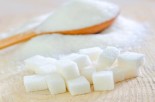Sugar is one of the most popular and most addicting ingredients found in your food.
However, you're probably unaware of just how much sugar you are actually eating on a daily basis.
In fact, Americans consume around 156 pounds of added sugars each year, and only 29 pounds of that sugar comes from traditional sugar cane.
Nutritionists suggests that Americans should only get 10 percent of their calories from sugar, or 13.3 teaspoons of sugar each day (based on 2,000 calories per day).
Are you aware that everything you consume contains sugar, whether it's naturally there or added in? Foods such as granola, cereals, bread, crackers, yogurt, soda and candy all contain added sugar.
Some foods contain natural sugars, such as fruit and veggies. For example, one large sized apple contains around 23g of natural sugar. This may seem like a lot but this sugar is in its natural state and is not being added in apple juice, for example.
How can you be sure that you're eating natural sugar?
The biggest step is making sure that you're reading the nutrition labels on foods before you buy and eat them. Also, eliminating sugary drinks for healthier options will help lower your sugar intake.
Research psychologist and neuroscientist and an expert in the fields of nutrition, diet and addiction, Nicole Avena, PhD, discusses why you're eating more sugar than you think, the difference between added and natural sugar and ways to decrease your sugar intake.
Sugar: Are You Eating Too Much By Accident?
Guest
: Nicole M. Avena, PhD
From the Show: HER
Summary: Sugar is one of the most popular and most addicting ingredients found in your food, and it's in nearly everything.
Air Date: 3/27/14
Duration: 10
Host: Michelle King Robson and Pamela Peeke, MD
Απολαύστε την εμπειρία ενός ζωντανού καζίνο με πραγματικούς ντίλερ στο Infinity Casino, προσφέροντας παιχνίδια όπως Live Blackjack και Live Roulette.




 Dr. Nicole Avena is a research psychologist and neuroscientist who is an expert in the fields of nutrition, diet and addiction.
Dr. Nicole Avena is a research psychologist and neuroscientist who is an expert in the fields of nutrition, diet and addiction.